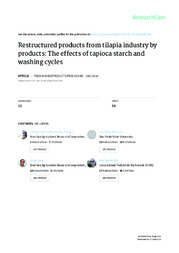Restructured products from tilapia industry by products: the effects of tapioca starch and washing cycles.
Restructured products from tilapia industry by products: the effects of tapioca starch and washing cycles.
Autoria: FOGACA, F. H. dos S.; SANT'ANA, L. S.; LARA, J. A. F. de; MAI, A. C. G.; CARNEIRO, D. J.
Resumo: The tilapia fileting industry generates large amounts of nutritionally significant waste material, and the recovery of this material is important. The manufacture of restructured products from mechanically recovered fish meat (MRFM) obtained from tilapia fileting allows the use of proteins of high biological value that would otherwise be discharged into the environment. The objective of this study was to evaluate the effect of washing cycles (either one cycle or five cycles) and of the addition of tapioca starch (20% vs. a no-starch control) on the characteristics of surimi obtained from MRFM produced by the tilapia industry and destined for use in restructured products. To evaluate the quality attributes of the product, the structure of a surimi protein matrix and its relationship to selected physicochemical parameters and morphological characteristics was assessed. Both the number of washing cycles and the starch addition were found to influence the moisture, protein and lipid content of the MRFM surimi. Higher whiteness was found after five washing cycles. Because the tapioca starch acted as a stabilizer, the fat globules were more stable and well distributed, and an emulsion with better properties resulted. A homogeneous network of fat globules linked to the protein matrix by a layer of tapioca starch was formed. Another advantage of this approach is that tapioca starch is gluten free. This property is important for specific groups in the population, e.g., celiac-intolerant consumers.
Ano de publicação: 2015
Tipo de publicação: Artigo de periódico
Unidade: Embrapa Meio-Norte
Observações
1 - Por padrão são exibidas publicações dos últimos 20 anos. Para encontrar publicações mais antigas, configure o filtro ano de publicação, colocando o ano a partir do qual você deseja encontrar publicações. O filtro está na coluna da esquerda na busca acima.
2 - Para ler algumas publicações da Embrapa (apenas as que estão em formato ePub), é necessário ter, no celular ou computador, um desses softwares gratuitos. Sistemas Android: Google Play Livros; IOS: iBooks; Windows e Linux: software Calibre.
Acesse outras publicações
Acesse a Base de Dados da Pesquisa Agropecuária (BDPA) para consultar o acervo completo das bibliotecas da Embrapa.

